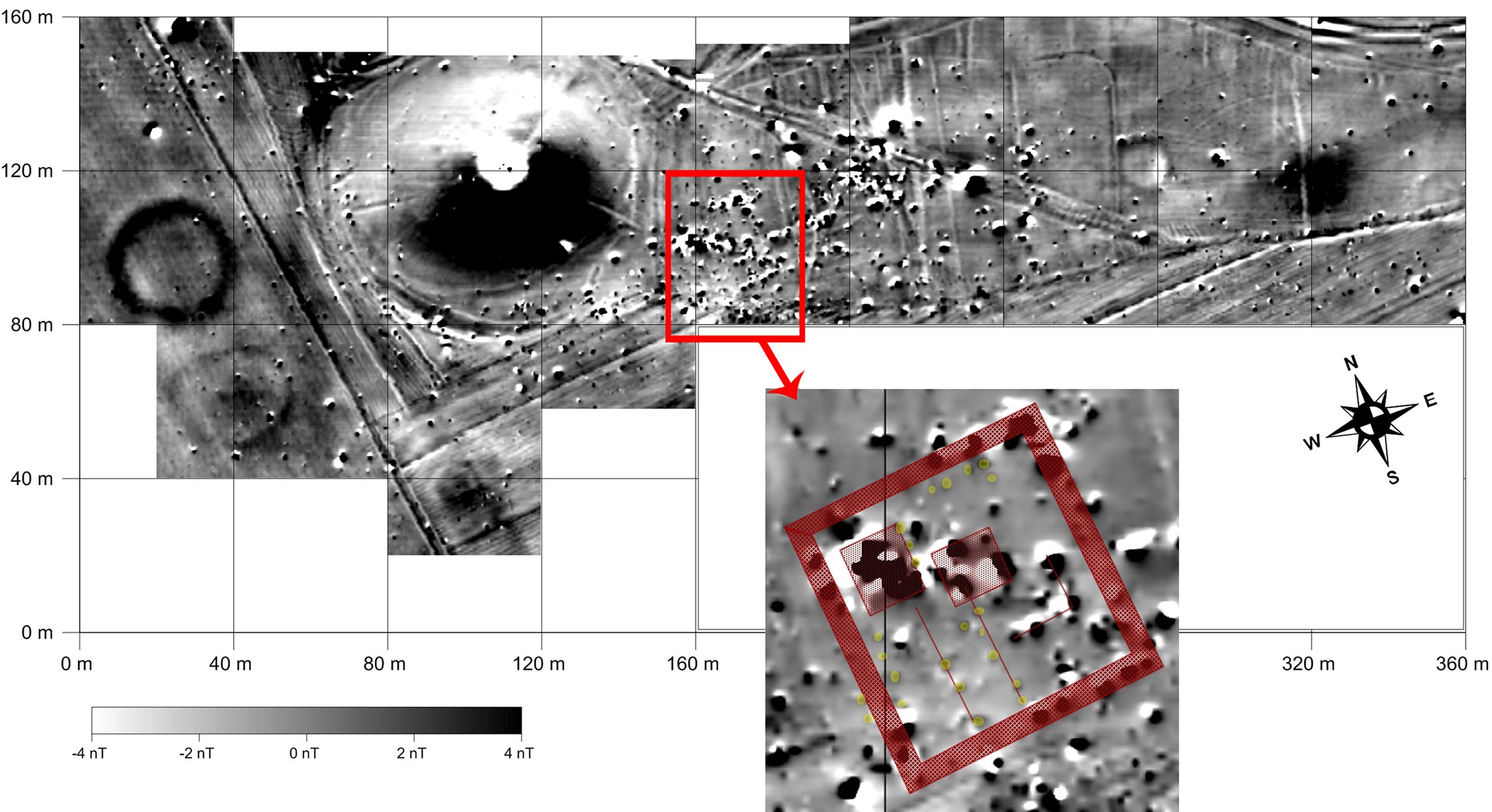Taking as its starting point excavated and well documented burial mounds (large-scale kurgans), this project explored the phenomenon of monumentality in the tombs of the Eurasian Steppes, as well as the tombs’ cultural, social and spatial impact. This phenomenon is examined from a broader, interregional perspective, taking into account the greatest possible number of noteworthy and researchable burial mounds from below the Danube up to the Yenisei.
Research
A new definition of Early Iron Age burial mound determines a large-scaled kurgan as a construction consisting a so called “kurgan periphery”, i.e. burials, hoards, trades of sacrifice rituals and other rituals, as well as built units and the kurgan’s immediate surrounding. The first preliminary studies of the kurgan periphery conducted in Siberia (Arzhan-2 2000-2004) and targeted research of the surroundings of kurgans in Kazakhstan (Topoi 1 research projects “Pyramids of the Steppe” and “Archeological and Geo-archeological Research in Kazakhstan”), have clearly shown the enormous potential of the kurgan periphery as a new source of information for both reconstructing the burial rites, as well as about the horse nomads communication network.
To broaden this knowledge, two targeted investigations of kurgan burial grounds and the large-scale kurgans periphery were undertaken with the help of geophysical survey within the Topoi II project phase (Fig. 1)

Fig. 1: Large Kurgan 1 of the necropolis Vinogradnyj-2. North Caucasus. Working moment | Photo by Julia Koch | © Stiftung Preußischer Kulturbesitz /Prussian Cultural Heritage Foundation
Results
The studies started in the central North Caucasus steppe (Russia), because according to written records this particular territory played a vital role as the starting point in the Scythian “heroic tale”, when groups of horse nomads undertook crusades in Western Asia in 7th century BC (Herodotus I, 103-106). Hence, the North Caucasus must have had an outstanding location status during the Early Iron Age.
Archeological-geophysical analysis in the North Caucasus (northern and western regions: Stavropol Krai, Krasnodar Krai, Russia) was supported by a geophysical team from Ludwig-Maximilians-Universität München under the supervision of Joerg Fassbinder, in cooperation with the Institute for Preventive Archaeology and Cultural Heritage “Nasledie”, Stavropol (Russia) headed by Andrei Belinskij, and Kuban State University under the supervision of Ivan Marchenko. 43 necropolises in central, eastern, and western North Caucasus have been explored in 10 area surveys since 2012, whereas 13 among them have been measured geophysically (total measurement surface: 36 ha). Two different space usage models of sacred areas around the kurgan (more specifically: within the burial ground) have been identified. Furthermore, components that are new in some of the kurgans and in various necropolises (e.g. rectangular ritual sites, ritual ring ditches, or hoof-shaped findings),have been discovered and described. Several parallel periphery construction forms have been recognized in the North Caucasus, as well as in the north of West Kazakhstan. This kind of findings has been completely unknown until the beginning of the examination in the Caucasus.
In addition, an excavation of the burial ground Sebgileevskoe-2 has been carried out with the support of the German Research Foundation, DFG (http://gepris.dfg.de/gepris/projekt/262000317). The acquired information about the kurgan construction, periphery usage, and the chronological study of the Scythian history in the North Caucasus have revealed new aspects for the historical reconstruction of this area. In cooperation with the Journalist Andrew Curry, some insights into the work have been published for a broader audience in popular science magazines : National Geographic Germany [“Warum die Skythen heulten” (→ www.nationalgeographic.de/
aktuelles/meldungen/warum-die-skythen-heulten ) ] and Archeology. A publication of the Archeological Institute of America [“Rites of the Sythians” (→ www.archaeology.org/issues/220-1607/features/4560-rites-of-the-scythians)]
The results of the research on Scythian monumental structures in the Caucasus and the comparative studies of the monumental kurgans periphery usage in the Caucasus (Topoi II) and Central Asia (research of the working group within Topoi I) were presented, discussed, and published during international conferences in Moscow, Saint Petersburg, Novosibirsk, Krasnodar, Barnaul (Russia, 2014-2018), Istanbul (Turkey, 2014), Warsaw (Poland, 2015), and Kalamata (Greece, 2016). Furthermore, the research findings were presented to expert audience in 2014 at the “8th German Archeological Congress” in Berlin and at the “4th (XX) All-Russian Archaeological Congress” in Kazan.
For the general public, the results of the archeological-geophysical analysis of the kurgan periphery were published in the “Science First Hand” magazine both in Russian [→ http://elementy.ru/nauchno-populyarnaya_biblioteka/433019/U_podnozhiya_tsarskikh_kurganov_Noveyshie_arkheologicheskie_i_geofizicheskie_issledovaniya) and in English [→ http://scfh.ru/en/papers/at-the-foot-of-royal-kurgans/] as well as on ResearchGate [→ www.researchgate.net/publication/305800449_At_the_Foot_of_Royal_Kurgans_The_latest_geoarchaeological_and_geophysical_studies] (Fig. 2).

Fig. 2: Magnetogram of the Early Iron Age necropolis and the adjacent Bi-Tjube periphery. Enlargement of architectonic findings. Magnetometer survey using Smartmag SM4G-Special cesium-magnetometer, sensitivity ±10 pT, variometer (duo-sensor) configuration, 40 x 40 m grid, spatial resolution 12.5 x 50 cm, interpolated to 25 x 25 cm, total intensity of the earth magnetic field: ca. 50.270 +/- 30 nT (April 2015), dynamics ± 4 nT, grey shade plot in 256 greyscales [red – stone foundations; yellow – postholes] | Magnetogram: Jörg Fassbinder, Andrei Asăndulesei | © Jörg Fassbinder; Stiftung Preußischer Kulturbesitz /Prussian Cultural Heritage Foundation/
Two pilot projects exploring large kurgans were carried out in the forest steppe of the Western Siberia and Transvolga steppe in the Volgograd region in order to gain further knowledge about the ritualistic use of large kurgan periphery and to find potential parallels between East European, Central Asian, and Siberian steppe regions. The examination was performed with new cooperation partners from Russia: Institute of Archeology and Ethnography of the Siberian Branch of the Russian Academy of Sciences (Novosibirsk) under the supervision of Vjacheslav Molodin (Topoi Senior Fellowship 2017) and Institute of Archaeology of the Russian Academy of Sciences (Moscow) under the supervision of Sergej Demidenko (Topoi Senior Fellowship 2017) in the Volgograd region. The results show some similarities in the area reaching from east of Western Siberia until west of the Kuban territory. Despite the fact that all the examined necropolises belonged to the Scythian cultural area, some subtle regional differences have been determined as well.
